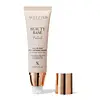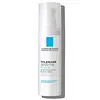What's inside
What's inside
 Key Ingredients
Key Ingredients

 Benefits
Benefits

 Concerns
Concerns

No concerns
 Ingredients Side-by-side
Ingredients Side-by-side

Water
Skin ConditioningButyloctyl Salicylate
Skin ConditioningGlycereth-26
HumectantEthylhexyl Salicylate
UV AbsorberGlycerin
HumectantCI 77891
Cosmetic ColorantDibutyl Adipate
EmollientCoco-Caprylate/Caprate
EmollientPentaerythrityl Tetraisostearate
EmollientBis-Ethylhexyloxyphenol Methoxyphenyl Triazine
Skin ConditioningMica
Cosmetic ColorantGlyceryl Stearate
EmollientPEG-100 Stearate
1,2-Hexanediol
Skin ConditioningMethyl Methacrylate Crosspolymer
Cetyl Alcohol
EmollientAcrylates Copolymer
Caprylyl Methicone
Skin ConditioningCeteareth-20
CleansingOleth-10
EmulsifyingTrideceth-9
EmulsifyingStearic Acid
CleansingAluminum Hydroxide
EmollientPolysorbate 80
EmulsifyingHydroxyacetophenone
AntioxidantPhenoxyethanol
PreservativePolyglyceryl-3 Distearate
EmulsifyingAmmonium Acryloyldimethyltaurate/Vp Copolymer
Parfum
MaskingSodium Polyacrylate
AbsorbentPalmitic Acid
EmollientCI 77492
Cosmetic ColorantBetaine
HumectantAllantoin
Skin ConditioningTrehalose
HumectantPanthenol
Skin ConditioningHydroxyethylcellulose
Emulsion StabilisingTriethoxycaprylylsilane
Ethylhexylglycerin
Skin ConditioningSodium Hyaluronate
HumectantCaprylyl Glycol
EmollientTocopherol
AntioxidantGlyceryl Stearate Citrate
EmollientSodium Phytate
Arginine
MaskingCI 77491
Cosmetic ColorantPotassium Cetyl Phosphate
EmulsifyingPolyacrylate Crosspolymer-6
Emulsion StabilisingMyristic Acid
CleansingSilica
AbrasiveT-Butyl Alcohol
PerfumingButylene Glycol
HumectantPolyglyceryl-10 Laurate
Skin ConditioningAcetyl Hexapeptide-8
HumectantCopper Tripeptide-1
Skin ConditioningTripeptide-1
Skin ConditioningPalmitoyl Pentapeptide-4
Skin ConditioningHexapeptide-9
Skin ConditioningWater, Butyloctyl Salicylate, Glycereth-26, Ethylhexyl Salicylate, Glycerin, CI 77891, Dibutyl Adipate, Coco-Caprylate/Caprate, Pentaerythrityl Tetraisostearate, Bis-Ethylhexyloxyphenol Methoxyphenyl Triazine, Mica, Glyceryl Stearate, PEG-100 Stearate, 1,2-Hexanediol, Methyl Methacrylate Crosspolymer, Cetyl Alcohol, Acrylates Copolymer, Caprylyl Methicone, Ceteareth-20, Oleth-10, Trideceth-9, Stearic Acid, Aluminum Hydroxide, Polysorbate 80, Hydroxyacetophenone, Phenoxyethanol, Polyglyceryl-3 Distearate, Ammonium Acryloyldimethyltaurate/Vp Copolymer, Parfum, Sodium Polyacrylate, Palmitic Acid, CI 77492, Betaine, Allantoin, Trehalose, Panthenol, Hydroxyethylcellulose, Triethoxycaprylylsilane, Ethylhexylglycerin, Sodium Hyaluronate, Caprylyl Glycol, Tocopherol, Glyceryl Stearate Citrate, Sodium Phytate, Arginine, CI 77491, Potassium Cetyl Phosphate, Polyacrylate Crosspolymer-6, Myristic Acid, Silica, T-Butyl Alcohol, Butylene Glycol, Polyglyceryl-10 Laurate, Acetyl Hexapeptide-8, Copper Tripeptide-1, Tripeptide-1, Palmitoyl Pentapeptide-4, Hexapeptide-9
 Reviews
Reviews

Ingredients Explained
These ingredients are found in both products.
Ingredients higher up in an ingredient list are typically present in a larger amount.
Caprylyl Glycol is a humectant and emollient, meaning it attracts and preserves moisture.
It is a common ingredient in many products, especially those designed to hydrate skin. The primary benefits are retaining moisture, skin softening, and promoting a healthy skin barrier.
Though Caprylyl Glycol is an alcohol derived from fatty acids, it is not the kind that can dry out skin.
This ingredient is also used as a preservative to extend the life of products. It has slight antimicrobial properties.
Learn more about Caprylyl GlycolGlycerin is already naturally found in your skin. It helps moisturize and protect your skin.
A study from 2016 found glycerin to be more effective as a humectant than AHAs and hyaluronic acid.
As a humectant, it helps the skin stay hydrated by pulling moisture to your skin. The low molecular weight of glycerin allows it to pull moisture into the deeper layers of your skin.
Hydrated skin improves your skin barrier; Your skin barrier helps protect against irritants and bacteria.
Glycerin has also been found to have antimicrobial and antiviral properties. Due to these properties, glycerin is often used in wound and burn treatments.
In cosmetics, glycerin is usually derived from plants such as soybean or palm. However, it can also be sourced from animals, such as tallow or animal fat.
This ingredient is organic, colorless, odorless, and non-toxic.
Glycerin is the name for this ingredient in American English. British English uses Glycerol/Glycerine.
Learn more about GlycerinWater. It's the most common cosmetic ingredient of all. You'll usually see it at the top of ingredient lists, meaning that it makes up the largest part of the product.
So why is it so popular? Water most often acts as a solvent - this means that it helps dissolve other ingredients into the formulation.
You'll also recognize water as that liquid we all need to stay alive. If you see this, drink a glass of water. Stay hydrated!
Learn more about Water